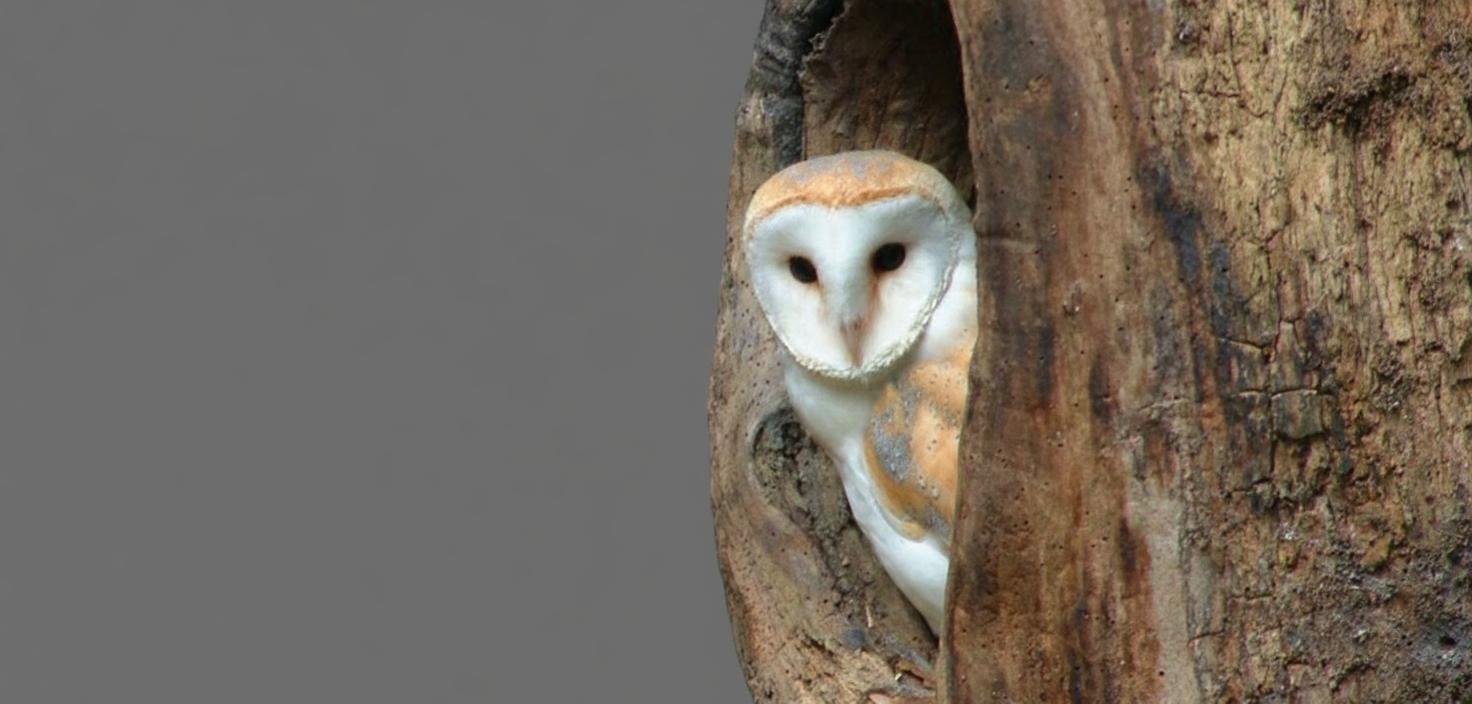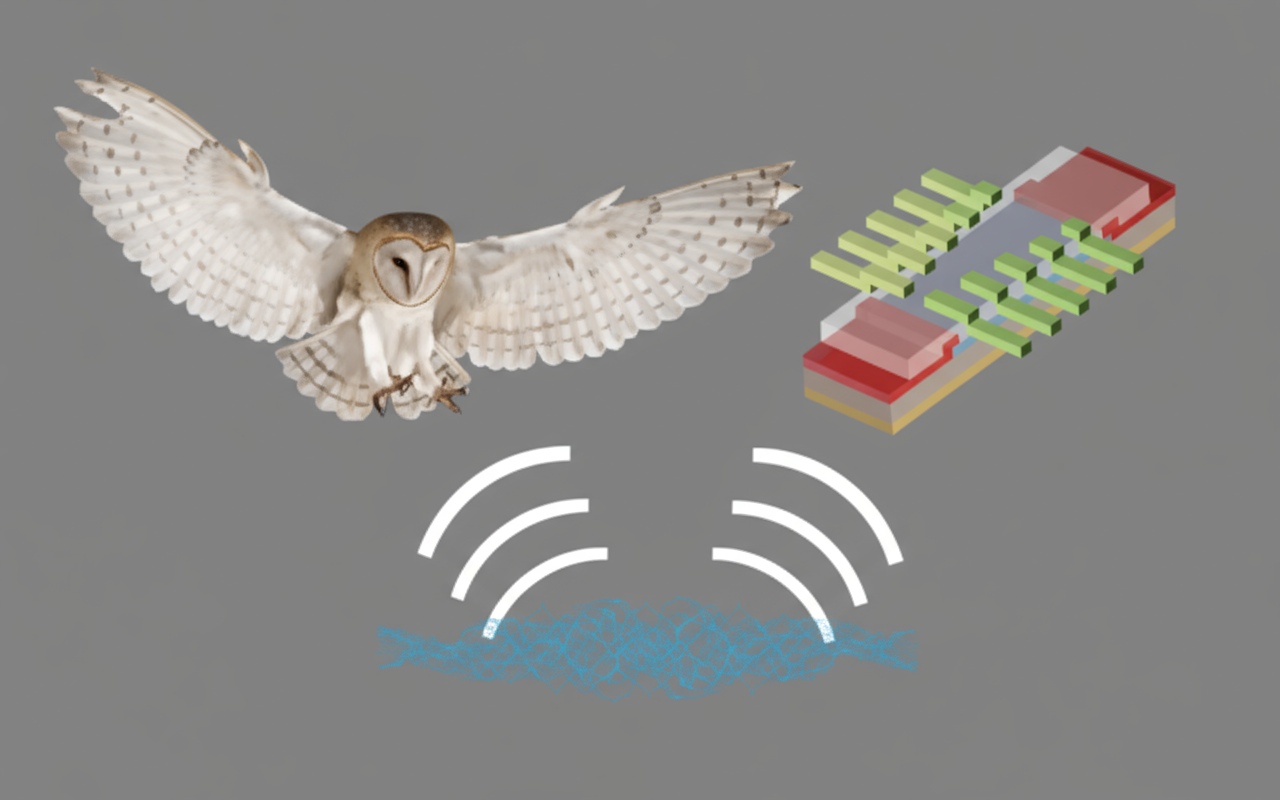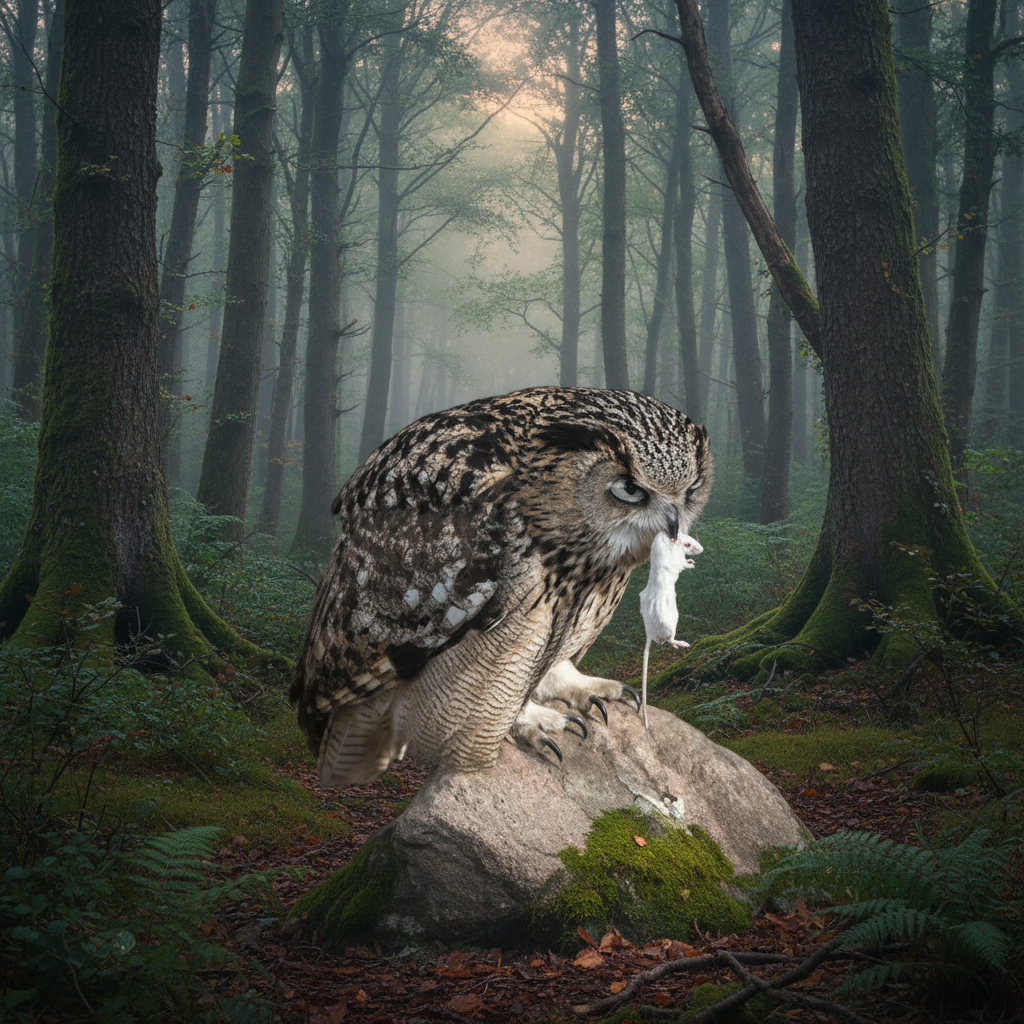When darkness falls across the landscape, most predators face significant limitations. But for owls, nighttime is prime hunting time. These extraordinary birds have evolved into what might be the most perfectly designed nocturnal hunters on our planet, capable of locating and capturing prey in conditions that would render most predators effectively blind and helpless.
Owls represent nature’s pinnacle of specialized night hunting adaptations. Unlike other predators that might compromise between daytime and nighttime capabilities, owls have evolved almost exclusively for after-dark hunting efficiency. Their entire physical structure – from specialized feathers to asymmetrical ears – serves a single purpose: to detect and capture prey in minimal light conditions with maximum effectiveness.
The true mastery of owl hunting becomes apparent when you consider their success rates. Studies tracking hunting efficiency across different predator species show that some owl species achieve success rates approaching 80% under ideal conditions – far exceeding the 10-20% success rates typical for most mammalian predators. This extraordinary efficiency stems from multiple specialized adaptations working in perfect concert rather than relying on a single hunting advantage.
Most impressive about owl hunting behavior is the near-complete silence with which they operate. While we often associate predators with dramatic chases or fierce struggles, owls represent the opposite end of the hunting spectrum – deploying stealth, precision, and surprise to such a degree that prey animals often remain unaware of the owl’s presence until the moment of capture. This hunting approach requires remarkable sensory capabilities combined with specialized physical adaptations that we’ll explore in depth.
The role of owls as nocturnal apex predators shapes entire ecosystems. Their hunting prowess helps control rodent populations, influencing everything from disease transmission to seed dispersal patterns in forest ecosystems. A single barn owl family can consume over 3,000 rodents annually, creating ripple effects throughout the food web. This ecological impact makes understanding owl hunting behavior relevant beyond mere fascination with their abilities.
Advances in night observation technology have revolutionized our understanding of owl hunting. Traditional research methods using visible light inevitably disturbed natural hunting behaviors, creating observation artifacts that misrepresented true patterns. Modern thermal imaging equipment like that from Pixfra allows researchers to document complete hunting sequences without detection by either owls or their prey, providing unprecedented insights into their true hunting behaviors.
The seasonal changes in owl hunting activity reveal another layer of sophistication. Most owl species adjust their hunting patterns throughout the annual cycle, with particularly intense activity during breeding seasons when they must provide for growing chicks. GPS tracking studies show some species like Great Horned Owls can expand their hunting territories by 30-40% during these high-demand periods, demonstrating remarkable behavioral flexibility despite their specialized hunting adaptations.
Owl Vision: Seeing in Near-Total Darkness
The visual capabilities of hunting owls represent one of the animal kingdom’s most remarkable sensory adaptations. While we often say someone has “eagle eyes” to denote exceptional vision, owls possess visual adaptations specifically evolved for the unique challenges of locating prey in extremely low-light conditions where even eagles would struggle to function.
The physical structure of the owl eye differs dramatically from human vision. While our eyes account for approximately 2% of our head weight, owl eyes can represent up to 5% of their total head weight – a disproportionate allocation that indicates their evolutionary priority. These oversized eyes feature significantly larger corneas and pupils relative to the eye size, allowing maximum light capture. The tubular shape of owl eyes, rather than the spherical structure of human eyes, creates greater distance between lens and retina, effectively functioning as a built-in telephoto lens that magnifies images.
Perhaps the most critical aspect of owl night vision involves their exceptional rod cell concentration. These specialized photoreceptor cells detect light and motion but not color, making them ideal for low-light conditions. While human retinas contain approximately 200,000 rods per square millimeter, owl retinas feature up to 1,000,000 rods per square millimeter. This five-fold density increase dramatically enhances their ability to detect even minimal light reflected from prey animals at night. This adaptation comes at the expense of cone cells (responsible for color vision), which explains why owls sacrifice color perception for superior night vision.
The position of owl eyes differentiates them from most birds. Their forward-facing placement creates binocular vision with approximately 70-degree overlap between the visual fields of both eyes. This arrangement provides exceptional depth perception – crucial for precisely judging striking distance when hunting. However, this frontal orientation limits peripheral vision, which owls compensate for with their extraordinary neck rotation capabilities. They can rotate their heads up to 270 degrees, allowing them to effectively see behind themselves without moving their bodies and potentially alerting prey.
“Owl visual systems represent one of evolution’s most remarkable sensory specializations. They don’t just see better than humans at night – they operate in a completely different visual realm, detecting and processing light information at levels that would appear as complete darkness to us. When combined with their other sensory adaptations, this creates a hunting system operating at the theoretical limits of biological possibility.” – Dr. Amanda Chen, Raptor Research Institute
The fovea structure within owl eyes – the region of highest visual acuity – shows interesting variations between species that reflect different hunting strategies. Unlike eagles that possess two foveal regions (one for forward vision, one for peripheral), most owl species have a single, highly concentrated fovea optimized exclusively for forward vision and striking accuracy. This represents another evolutionary trade-off, sacrificing wide-field scanning capabilities for unsurpassed precision in the area directly relevant to prey capture.
Light amplification capabilities within owl eyes far exceed human abilities. Research measuring minimum light thresholds shows that owls can effectively hunt in light conditions approximately 10-100 times dimmer than what humans require for basic functional vision. This extraordinary sensitivity comes partly from specialized enzymes that regenerate light-detecting molecules in rod cells much faster than in human eyes, allowing continuous function in extremely low light. This regeneration speed means owls can maintain visual function under sustained low-light conditions where human night vision would gradually deteriorate.
Despite these remarkable adaptations, owls don’t rely exclusively on vision when hunting in complete darkness. When light levels fall below even their exceptional detection thresholds, they seamlessly transition to their backup sensory system – their extraordinary hearing capabilities. Modern thermal imaging equipment from companies like Pixfra mimics these capabilities, detecting prey heat signatures that would be invisible to both human eyes and traditional night vision systems that require some ambient light.
The Pixfra Rail mounting system provides a stable platform for thermal imaging equipment that allows researchers and wildlife enthusiasts to observe these remarkable visual capabilities without disrupting the owls’ natural behavior. The standardized Picatinny interface ensures compatible mounting with various observation devices, facilitating detailed documentation of how owls use their extraordinary vision during complete darkness.
Owl Hearing: Pinpointing Prey by Sound Alone
The auditory capabilities of hunting owls represent perhaps their most extraordinary adaptation for nocturnal hunting. While their vision excels in low light, their hearing allows them to locate prey with pinpoint accuracy in complete darkness or when prey is hidden under vegetation, snow, or leaf litter – conditions where visual detection becomes impossible regardless of light sensitivity.
The most distinctive feature of owl hearing involves the asymmetrical placement of their ear openings. Unlike humans and most animals with ears positioned symmetrically on both sides of the head, many owl species have one ear opening positioned higher on the skull than the other. This vertical offset creates minute differences in sound arrival time and intensity between the ears. These differences allow owls to triangulate sound sources with remarkable precision in three-dimensional space – not just direction but also exact distance and depth. Studies measuring this accuracy have documented Great Grey Owls precisely locating mice under 18 inches of snow with no visual cues whatsoever.
The facial disc structure that gives owls their distinctive appearance serves a critical acoustic function. This concave arrangement of specialized feathers acts as a parabolic sound collector, gathering and focusing sound waves toward the ear openings. High-speed video analysis shows owls can subtly adjust the shape of this facial disc, effectively “aiming” their acoustic reception toward specific sound sources – similar to how a satellite dish can be repositioned to capture different signals. This adjustable sound collection system significantly enhances their ability to isolate prey sounds from background noise.
The extreme sensitivity of owl hearing exceeds human capabilities by orders of magnitude. Scientific measurements demonstrate that some owl species can detect sound intensities approximately 10-100 times fainter than the quietest sounds detectable by human ears. This sensitivity allows them to hear the minuscule sounds produced by prey animals at considerable distances – a mouse’s heartbeat from several meters away or the sound of rodent teeth gnawing on seeds through substantial ground cover.
The frequency range of owl hearing shows interesting specialization for prey detection. While humans hear frequencies between approximately 20 Hz and 20,000 Hz, barn owls can detect sounds between 200 Hz and 12,000 Hz – a narrower overall range but with dramatically enhanced sensitivity within the specific frequencies produced by their prey animals. This specialized frequency detection represents another evolutionary trade-off, sacrificing broader hearing range for extraordinary sensitivity within the most relevant sound spectrum for hunting success.
Brain processing of auditory information represents another remarkable aspect of owl hearing. Approximately 25% of an owl’s midbrain is dedicated to auditory processing, compared to about 4% in humans. This disproportionate allocation demonstrates the evolutionary priority placed on sound processing. The specialized auditory neurons in this enlarged region create detailed acoustic maps allowing owls to maintain continuous spatial awareness of sound sources even when those sounds are brief or intermittent. This neural architecture explains how owls can strike with remarkable accuracy at the exact location where they last heard prey movement, even after complete silence for several seconds.
Laboratory studies measuring owl response to artificial sound sources demonstrate their extraordinary acoustic precision. Barn owls consistently locate sound sources within 1-2 degrees of the actual direction in complete darkness – the equivalent of pinpointing a sound within a circle the size of a quarter from 8 feet away. This precision exceeds what humans can achieve even under ideal conditions and with conscious effort. For owls, this level of acoustic accuracy happens automatically and instantaneously during high-speed hunting approaches.
The combination of these auditory adaptations creates what researchers call “acoustical gaze” – the ability to maintain precise awareness of prey location using sound alone. This capability means owls can successfully hunt in conditions that defeat most other predators: complete darkness, dense fog, heavy vegetation cover, or even prey hidden under snow. When combined with their specialized flight adaptations that we’ll explore next, this creates a hunting system with remarkably few environmental limitations.
Silent Flight: The Ultimate Stealth Technology
Perhaps the most extraordinary aspect of owl hunting involves their specialized feather adaptations that create nearly silent flight. This acoustic stealth represents a remarkable evolutionary achievement, essentially eliminating the sound of air movement over their wings and body that would otherwise alert prey to their approach. The resulting silent flight capability allows owls to maintain their acoustic advantage throughout the final approach and strike phases of hunting.
The leading edge of owl wings features unique serrated feathers unlike those found in any other bird group. These comb-like serrations, called fimbriae, break up the smooth airflow over the wing surface, eliminating the whistling sound typically produced by air passing over a smooth edge. High-speed photography reveals these serrations creating thousands of tiny micro-turbulences that effectively silence the airflow across the entire wing surface. This adaptation represents nature’s solution to the same aerodynamic challenge that military stealth aircraft designers struggle with – how to move through air without creating detectable acoustic signatures.
The trailing edge of owl wings contains another specialized feature: a flexible fringe of soft feathers that further reduces flight noise. This fringe essentially muffles the sound of air flowing off the back of the wing, preventing the formation of noisy vortices that occur in other birds. Aerodynamic testing of owl feathers versus other birds of similar size shows this trailing edge adaptation reduces flight noise by approximately 10-18 decibels – the difference between a normal conversation and a whisper. This noise reduction proves particularly critical during the final moments of an attack when the owl is closest to prey with acute hearing.
The overall surface of owl feathers differs significantly from other birds. Microscopic examination reveals a velvety texture with specialised barbules (small hook-like structures) that dampen sound by absorbing acoustic energy rather than reflecting it. This soft surface effectively absorbs most of the minimal sound created by feathers moving against each other during flight. The acoustic benefit comes with a cost – these specialized feathers require more maintenance and are less water-resistant than the smoother feathers of other birds, demonstrating the evolutionary priority placed on silent flight over other potential advantages.
Flight patterns during hunting approaches show another layer of acoustic strategy. Unlike many birds that maintain constant wingbeat patterns, owls frequently adjust their flight cadence when approaching prey – often shifting to a gliding approach for the final meters before striking. This variable flight pattern minimizes repetitive sounds that might otherwise alert prey to their approach. GPS tracking studies show owls consistently selecting flight paths that take advantage of ambient sounds (like wind through trees) to further mask their approach, suggesting they actively consider the acoustic environment when hunting.
Foot structure complements the silent flight adaptations with specialized features for silent prey capture. Owls possess unusually long legs for their body size, covered with specially adapted feathers that both silence movement and provide insulation during cold weather hunting. Their feet feature reversible outer toes that can rotate forward or backward, allowing different grip configurations depending on prey size and type. This adaptability enables secure capture with minimal struggle, reducing sounds that might alert other nearby prey animals.
The combined result of these adaptations is truly remarkable. Laboratory measurements using highly sensitive microphones have documented owl flight producing sound levels below 20 decibels (comparable to human breathing) at distances where other birds of similar size produce sounds exceeding 40-50 decibels. This 30+ decibel reduction represents an enormous acoustic advantage, essentially making owls acoustically invisible to prey until the moment of contact. For context, each 10-decibel reduction represents a halving of perceived loudness, meaning owl flight registers approximately 1/8th as loud as comparable birds.
Thermal imaging equipment from Pixfra has enabled unprecedented documentation of these silent hunting approaches without disrupting natural behavior. By detecting the heat signatures of both owl and prey, researchers can now observe complete hunting sequences that would be virtually impossible to witness using traditional observation methods, particularly in complete darkness when owls are most active.
Hunting Techniques: Varied Approaches to Night Predation
Owl hunting techniques show remarkable diversity across different species, reflecting specialized adaptations to particular prey types and habitat conditions. While all owls share core adaptations for nocturnal hunting, their specific tactical approaches reveal fascinating variations that maximize hunting success in their particular ecological niches.
Perch-and-pounce hunting represents the most common owl hunting strategy, employed primarily by woodland and field-edge species like Barred Owls and Great Horned Owls. This method involves selecting elevated observation points with good acoustic and visual coverage of hunting grounds, then waiting patiently until prey is detected. GPS tracking studies show these owls typically maintain a network of 8-15 preferred perches distributed throughout their territory, rotating between them strategically based on prey activity patterns, wind direction (for scent detection), and recent hunting success. The perches typically provide both concealment and clear flight paths to likely prey locations. Once prey is detected, these owls launch with remarkable acceleration – reaching speeds of 20-30 mph within just 2-3 wingbeats.
Quartering flight patterns characterize the hunting approach of open-country specialists like Barn Owls and Short-eared Owls. Rather than hunting from static perches, these species fly continuously along systematic search paths, typically 3-6 feet above ground level. This methodical coverage allows them to bring their exceptional hearing to bear across large open areas where suitable perches might be limited. Thermal imaging studies show these flight patterns aren’t random but highly structured, with owls maintaining precise spacing between search lines to ensure complete acoustic coverage of hunting territories. This active hunting approach requires greater energy expenditure than perch hunting but allows exploitation of prey-rich open habitats where the perch-and-pounce method would be impractical.
Specialized fishing techniques appear in species like Fishing Owls (Ketupa spp.) and occasionally Great Grey Owls. These remarkable adaptations involve detecting fish near water surfaces using a combination of visual identification and subtle surface movement detection. Unlike other owl prey that can be located acoustically, fish require specialized hunting approaches involving precisely timed strikes that penetrate water surfaces with minimal splash. These owl species possess modified talons with specialized scales and spicules that improve grip on slippery prey. Some fishing specialists even have reduced facial discs compared to other owls – a modification that suggests reduced reliance on acoustic hunting in favor of visual detection when targeting aquatic prey.
| Owl Species | Primary Hunting Technique | Peak Activity Hours | Main Prey Types |
|---|---|---|---|
| Barn Owl | Quartering Flight | 10 PM – 2 AM | Small rodents, shrews |
| Great Horned Owl | Perch-and-Pounce | Dusk and Dawn | Medium mammals, birds |
| Northern Saw-whet | Systematic Forest Search | All Night | Mice, small birds |
| Burrowing Owl | Mixed (Ground ambush) | Crepuscular | Insects, small rodents |
| Great Gray Owl | Perch-Pounce + Dive | Variable | Voles, pocket gophers |
Dive techniques used by several northern species like Great Gray and Boreal Owls show remarkable physical capabilities. When hunting prey beneath snow cover, these owls can strike with sufficient force to break through crusted snow surfaces that would support animals weighing 10-15 times more than their prey. High-speed video analysis reveals they achieve this through a combination of precise targeting (hitting with focused force rather than distributed weight) and specialized plunging techniques that maximize impact energy. The dive force generated can exceed 3-4 times their body weight, allowing them to punch through surfaces that would otherwise protect prey from most predators. This specialized technique enables winter hunting success when many other predators struggle to access food sources.
The striking accuracy of hunting owls demonstrates the extraordinary precision of their sensory systems. Research measuring strike precision shows Barn Owls consistently capturing prey within 1-2 centimeters of their intended target point, even in complete darkness. This accuracy reflects the perfect integration of their sensory adaptations with the neural mapping systems that coordinate their physical movements. Perhaps most impressive, this precision occurs during extremely high-speed attacks – with final approaches often exceeding 20-25 mph, requiring calculations that account for both the owl’s movement and potential prey responses.
Seasonal and weather-based variations in hunting techniques demonstrate considerable behavioral flexibility. During heavy rainfall that might dampen their specialized feathers and reduce acoustic efficiency, many owl species shift toward more visually-based hunting methods and target different prey types. Similarly, deep winter snow conditions trigger technique adaptations in northern species, with modifications to striking force and foot placement that maintain hunting success despite challenging environmental conditions. This tactical flexibility extends their hunting capabilities across seasonal extremes that might otherwise limit their effectiveness.
Modern observation technologies have revealed previously unknown hunting behaviors. Thermal equipment from Pixfra has documented cooperative hunting behaviors between mated owl pairs – behaviors rarely observed using traditional methods. These coordinated tactics typically involve one owl deliberately flushing prey toward areas where the partner waits in ambush. While not as complex as the pack hunting strategies seen in some mammals, these cooperative behaviors show more sophisticated coordination than previously attributed to typically solitary owls.
The stable mounting capabilities provided by the Pixfra Rail system have proven invaluable for documenting these varied hunting techniques. The standardized Picatinny interface ensures compatible mounting with various observation devices, allowing extended monitoring sessions that capture the full range of hunting behaviors across different conditions and seasons.
Owl Diets: What They Hunt at Night
The dietary patterns of hunting owls reveal fascinating ecological relationships and hunting specializations. While popular imagination often associates owls primarily with mice, their actual prey selection shows remarkable diversity across species, with dietary compositions that reflect both evolutionary adaptations and tactical hunting opportunities.
Small mammal specialization represents the core dietary focus for most temperate zone owls, with rodents constituting 60-90% of prey items for species like Barn Owls, Great Gray Owls, and Long-eared Owls. This specialization makes ecological sense – small mammals represent the most abundant and reliable nocturnal prey base in most terrestrial ecosystems. The high reproductive rates and year-round activity patterns of many rodent species provide consistent food sources even when other prey might be seasonally limited. Analysis of owl pellets (regurgitated indigestible remains) shows remarkable diversity within this category, with some specialists like Barn Owls documented consuming over 30 different rodent species across their range.
Bird predation features prominently in the diets of several larger owl species, particularly Great Horned Owls and Eurasian Eagle Owls. These powerful hunters regularly target sleeping birds, with hunting patterns that specifically exploit the vulnerability of roosting prey. Research using GPS tracking collars shows these owls systematically checking known bird roosting sites during their nightly hunting circuits, with particular focus on communal roosts that concentrate potential prey. Their powerful talons allow them to capture birds up to their own body weight, including other raptors like hawks and smaller owl species. This bird predation capability significantly expands their potential prey base beyond what’s available to strict mammal specialists.
Insect consumption plays a surprisingly important role for many owl species, particularly during summer months when insects reach peak abundance. Small owl specialists like Elf Owls and Screech Owls may derive 70-80% of their summer diet from large insects like moths, beetles, and grasshoppers. Even larger species that primarily target vertebrates often opportunistically consume substantial insect biomass when available. This dietary flexibility allows exploitation of seasonally abundant food sources while maintaining hunting skills for larger prey. The smallest owl species may consume hundreds of individual insects nightly during peak abundance periods.
Amphibian and reptile predation becomes significant in the diets of many tropical and subtropical owl species, with frogs, lizards, and snakes featuring prominently in dietary analyses. Species like the Spectacled Owl of Central and South America show specific hunting adaptations for capturing tree frogs and arboreal lizards from vegetation surfaces. The Australian Powerful Owl includes a high percentage of arboreal reptiles in its diet. These prey types provide important protein sources in ecosystems where mammal diversity or abundance might be lower than in temperate regions.
Specialized diet components appear in several owl species with unique hunting adaptations. The cave-dwelling Oilbird (technically not a true owl but a nightbird with convergent adaptations) specializes in fruit consumption despite hunting nocturnally. Several fishing owl species target aquatic prey almost exclusively. The Pel’s Fishing Owl of Africa shows extreme specialization, with fish constituting over 90% of its diet, while the Blakiston’s Fish Owl of Asia includes significant percentages of aquatic invertebrates like crabs alongside fish prey. These specialized diets reflect both habitat adaptations and reduced competition by exploiting prey types that most other owls ignore.
Seasonal dietary shifts demonstrate remarkable flexibility across many owl species. Great Horned Owls show substantial seasonal variation, with mammal consumption peaking during winter months when other prey is limited, then diversifying to include more birds, reptiles, and even insects during spring and summer. These shifts reflect both changing prey availability and the energetic demands of breeding seasons when provisioning nestlings requires maximizing overall food acquisition rather than specializing on preferred prey that might be limited in availability.
“Owl dietary analysis reveals not just what they eat, but how ecosystems function at night. Their pellets provide snapshots of nocturnal biodiversity otherwise invisible to researchers. When we study what owls hunt, we’re essentially using them as ecological sampling tools that reveal entire communities of nocturnal animals that would be extraordinarily difficult to document using traditional survey methods.” – Dr. Marcus Rodriguez, Nocturnal Ecology Research Center
Unusual prey items documented in owl diets demonstrate their opportunistic hunting capabilities. Great Horned Owls have been recorded taking prey as diverse as skunks, domestic cats, and even young foxes – animals that themselves are typically predators rather than prey. Barn Owls occasionally capture bats in flight, demonstrating remarkable interception capabilities against extremely agile prey. These unusual items rarely constitute significant dietary percentages but highlight the adaptability and hunting prowess that allows owls to exploit situational opportunities despite their specializations.
Geographic variations in owl diets reflect local prey availability and ecological conditions. The same owl species often shows dramatically different dietary compositions across different portions of its range. For example, Barn Owl diets in coastal regions may include up to 15-20% shorebirds and waterfowl, while individuals just 50 miles inland might consume 95%+ rodents. These regional adaptations demonstrate considerable behavioral flexibility that maximizes hunting success across diverse habitat conditions despite consistent hunting method specializations.
How to Observe Night Owls with Modern Technology
Witnessing owl hunting in its full nocturnal glory represents one of wildlife observation’s greatest challenges. The combination of darkness, owl stealth, and the brief, explosive nature of their attacks means that traditional observation methods capture only fragments of their true hunting behavior. Modern technology has revolutionized this field, creating unprecedented opportunities to witness and document complete owl hunting sequences without disturbing natural behaviors.
Thermal imaging technology represents the single most significant advancement for nocturnal owl observation. Unlike traditional night vision that requires some ambient light source, thermal devices detect the heat signatures of animals directly, allowing observation in complete darkness, through light vegetation, and even in adverse weather conditions like fog or light rain. High-quality thermal imaging equipment like that from Pixfra can detect owl-sized heat signatures at distances exceeding 500 yards under optimal conditions, providing unprecedented observation opportunities while maintaining distances that don’t influence natural behavior.
The non-invasive nature of thermal observation represents its greatest advantage for owl research. Unlike traditional wildlife viewing methods that often require lights or close approaches, thermal observation allows completely passive monitoring without alerting owls to human presence. This technology reveals truly natural behaviors rather than reactions to human disturbance. For enthusiasts interested in this approach, the Pixfra Rail mounting system provides stable mounting options for extended observation sessions without the fatigue of hand-holding equipment.
Location selection dramatically influences successful owl observation. Studies of owl movement patterns identify several high-probability locations for witnessing natural hunting sequences:
- Field/forest interfaces, particularly along overgrown fencerows
- Meadow edges adjacent to woodland areas
- Recently mowed fields where prey visibility and access are temporarily increased
- Woodland clearings, especially those with scattered perch trees
- Riparian corridors where concentrated prey populations attract regular hunting activity
When selecting observation positions, maintaining awareness of wind direction proves essential, as owls’ excellent sense of smell can detect human scent if positioned downwind. Situating yourself with wind carrying your scent away from likely owl approach directions significantly improves observation opportunities without influencing natural behavior.
Equipment stabilization represents another critical factor for successful observation, particularly when using high-magnification thermal devices at extended distances. Hand-holding thermal optics becomes impractical during extended observation sessions, leading to missed opportunities during crucial hunting moments. The Pixfra Rail mounting system provides a stable platform compatible with various observation devices through its standardized Picatinny interface, enabling hours of comfortable observation without the fatigue that would otherwise limit viewing sessions.
Seasonal timing significantly impacts observation success rates. Owl hunting activity doesn’t distribute evenly throughout the year but concentrates during specific seasonal windows. For most temperate zone species, late winter represents the peak period for observing hunting behavior, as breeding season approaches and territories are actively defended. This period combines increased hunting activity with slightly longer daylight that helps locate likely observation areas before complete darkness. Spring brings another excellent observation window when adults must hunt intensively to feed growing nestlings, often making more hunting attempts within smaller geographic areas around nest sites.
The ethical considerations for owl observation deserve careful attention. The fundamental principle should always be non-disturbance – if your presence alters natural behavior patterns, you’re too close or otherwise detectable. Responsible observation practices include:
- Maintaining minimum observation distances (typically 300+ feet)
- Avoiding artificial lighting of any kind
- Minimizing conversation and unnecessary movement
- Never approaching nesting sites during breeding season
- Never using playback calls to attract owls during sensitive periods
Remember that habituating owls to human presence, even for observation purposes, can create dangerous situations for both owls and other humans who may encounter them later. Thermal technology’s greatest advantage may be allowing observation without habituation risks that come with repeated detection.
Audio recording technology provides another valuable dimension for owl observation, documenting vocalizations and hunting sounds typically inaudible at normal observation distances. Specialized parabolic microphones or wildlife-specific recording systems can capture the subtle sounds of owl movements and prey capture events that would otherwise remain undetected. When synchronized with thermal video documentation, these recordings create comprehensive records of hunting behaviors that span multiple sensory dimensions.
Remote camera technologies offer another approach to owl observation, particularly for monitoring regular perching or nesting locations. Modern trail cameras with no-glow infrared flash systems can document owl activities without visible light that might disturb natural behavior. The latest systems include cellular connectivity that transmits images in real-time, allowing observers to monitor activity without repeatedly visiting sites and leaving human scent that might alter owl behavior patterns.
Owl Conservation and Threats to Night Hunters
The specialized adaptations that make owls such extraordinary night hunters also create unique vulnerabilities to environmental changes and human activities. Understanding these conservation challenges helps ensure these remarkable predators can continue their ecological roles and provides context for appreciating their specialized hunting adaptations.
Habitat loss represents the most significant threat to owl populations globally. The specialized hunting requirements of many owl species mean they cannot simply relocate to any available woodland or field when their preferred habitats disappear. Species like the Spotted Owl require large contiguous tracts of old-growth forest with specific structural characteristics that support both their hunting techniques and prey base. Research tracking owl territory abandonment shows direct correlations with habitat fragmentation thresholds – many species cannot maintain viable populations when their habitat becomes fragmented below certain patch sizes, even if the total habitat area remains substantial.
Light pollution creates a growing threat specifically targeting nocturnal hunters. Artificial lighting disrupts natural darkness in expanding areas worldwide, interfering with owl hunting in multiple ways. Direct illumination of hunting areas can eliminate the sensory advantages owls depend on, while diffuse sky glow affects prey behavior and activity patterns. Studies measuring hunting success rates under different artificial lighting conditions show some owl species experience 35-50% reductions in prey capture rates in areas with significant light pollution. Unlike habitat loss that creates obvious population impacts, light pollution often produces subtle sub-lethal effects that gradually reduce reproductive success and population viability.
Rodenticide poisoning has emerged as a particularly insidious threat to owls worldwide. As specialized predators of rodents, owls consume prey that has ingested poison, creating secondary poisoning effects that have decimated populations in some regions. Research analyzing tissues from dead owls in suburban and agricultural areas shows alarming prevalence of anticoagulant rodenticide compounds, with studies in California documenting these compounds in 70-90% of owls tested. These poisons cause internal hemorrhaging, reduced hunting efficiency through impaired coordination, and ultimately death. The compounds persist in owl tissues for months, gradually accumulating with each poisoned prey item consumed.
Vehicle collisions cause significant owl mortality, particularly among species that hunt along roadside verges where small mammal populations often concentrate. Road design features like vegetated medians create artificial hunting corridors that attract owls while simultaneously exposing them to traffic hazards. Species with hunting styles involving low quartering flight, like Barn Owls and Short-eared Owls, suffer particularly high mortality rates. GPS tracking studies in the UK documented 40-55% of tracked Barn Owls dying from vehicle collisions within their first year, highlighting the magnitude of this threat in developed landscapes.
Climate change affects owl populations through multiple mechanisms, many specifically impacting their specialized hunting capabilities. Changing precipitation patterns alter prey abundance and activity, while temperature shifts affect both prey distribution and the timing of owl breeding relative to peak prey availability. Species with highly specialized prey relationships face particular challenges as climate disruptions cascade through food webs. Northern species that hunt through snow, like Great Gray Owls, face additional challenges as snow conditions become less predictable, affecting both their hunting success and the insulative properties of snow that their prey depend on for winter survival.
Conservation solutions specific to owl hunting needs have shown promising results when properly implemented. These include:
- Dark sky preserves that maintain natural darkness in critical hunting areas
- Installation of nest boxes that provide secure breeding sites in fragmented habitats
- Traffic calming measures in high-mortality road segments
- Promotion of integrated pest management alternatives to rodenticides
- Habitat corridor preservation connecting hunting territories across fragmented landscapes
These targeted conservation approaches recognize the specialized nature of owl hunting adaptations and seek to preserve the conditions they require rather than simply protecting generic habitat area.
Public education about owl ecology plays a crucial role in conservation efforts. While many people appreciate owls aesthetically, fewer understand their ecological importance and specific conservation needs. Thermal imaging technology from companies like Pixfra has created new opportunities for public engagement, allowing people to witness the extraordinary hunting capabilities of owls without disturbing natural behaviors. These education opportunities build broader support for conservation initiatives that might otherwise lack public understanding or support.
The ecological consequences of owl population declines extend far beyond the birds themselves. As top nocturnal predators, owls exert controlling influences on numerous prey species, creating ripple effects throughout ecosystems when their populations decline. Research in areas where owl populations have been experimentally removed shows significant changes in rodent behavior, plant community composition, and disease prevalence – demonstrating the keystone role these predators play in maintaining ecological balance.
FAQs About Owl Night Hunting
How can owls see in complete darkness?
They can’t actually see in complete darkness – but they don’t need to! While owls have incredible night vision (5-10 times better than humans in low light), their true superpower is their asymmetrical ears. One ear sits higher on their skull than the other, allowing them to triangulate prey location with astonishing precision using sound alone. This 3D acoustic mapping is so accurate that Great Gray Owls can locate and catch mice running beneath 18 inches of snow without seeing them at all. Their specialized facial disc feathers function like a satellite dish, collecting and focusing sound waves toward their ear openings. When combined with their exceptional night vision that can function in moonlight or starlight, this multi-sensory hunting system works in conditions that would leave most predators completely helpless. Modern thermal imaging equipment from Pixfra works similarly, detecting prey heat signatures that would be invisible to both human eyes and traditional night vision systems.
Why is owl flight completely silent?
Owl flight represents nature’s perfect stealth technology through three specialized feather adaptations. First, their leading wing edges have unique comb-like serrations (called fimbriae) that break up airflow and eliminate the whistling sound other birds create. Second, their trailing wing edges have soft flexible fringes that prevent noisy vortices as air flows off their wings. Finally, their overall feather surface has a velvet-like microstructure that absorbs rather than reflects sound. Laboratory measurements show owl flight produces sounds below 20 decibels (quieter than human breathing) compared to 40-50 decibels for similar-sized birds – a difference that makes them effectively acoustically invisible to prey with sensitive hearing. This silent flight capability provides their critical final approach advantage, allowing them to maintain their hearing advantage throughout the entire hunting sequence. The specialized feathers require more maintenance and provide less water resistance than other birds’ feathers, showing the evolutionary priority placed on silent hunting over other potential advantages.
What makes owls more efficient night hunters than other predators?
Owls achieve night hunting success rates up to 80% in ideal conditions – dramatically higher than most mammalian predators’ 10-20% success rates – through the perfect integration of specialized adaptations. Their exceptional hearing can detect a mouse heartbeat from several meters away, while their silent flight prevents prey from detecting their approach. Unlike many predators that must chase prey, owls employ precision strike hunting – capturing prey with a single deadly accurate attack rather than energy-intensive pursuits. Their specialized foot structure, with two toes pointing forward and two backward (unique among birds), creates a remarkably effective gripping mechanism that immediately immobilizes prey upon impact. Most impressively, these adaptations work in concert rather than independently – creating a hunting system that functions across varied conditions from moonlit nights (where vision dominates) to complete darkness under dense canopy (where hearing becomes primary). This multi-sensory flexibility allows successful hunting in conditions that would defeat most other predators.
How far can owls detect prey at night?
Owl prey detection distances vary dramatically depending on conditions and sensory methods used. Their visual system can detect small rodent movement up to 150-300 feet away under moderate moonlight, while their acoustic system can pinpoint prey sounds at distances of 75-100 feet in quiet conditions. Most impressively, their olfactory capabilities (often overlooked) can detect concentrations of rodent scent from distances exceeding 150 feet when wind conditions are favorable. Research using controlled sound sources shows Barn Owls consistently locate penny-sized sound sources in complete darkness with 1-2 degree accuracy – equivalent to targeting a mouse-sized object within a quarter-sized area from 25 feet away. This multi-sensory detection capability explains how owls maintain hunting effectiveness across dramatically different environmental conditions. For wildlife observers, thermal imaging equipment from Pixfra provides similar detection capabilities, allowing observation of complete hunting sequences without disrupting natural behaviors with visible light that would alter both owl and prey behavior.
Do all owls hunt using the same methods at night?
No – owl hunting techniques vary dramatically between species, reflecting specialized adaptations to particular habitats and prey types. Woodland specialists like Barred Owls typically employ perch-and-pounce techniques, systematically moving between elevated hunting posts until they detect prey below. Open-country specialists like Barn Owls use quartering flight patterns, flying methodically back and forth across fields while using their exceptional hearing to detect prey. Northern specialists like Great Gray Owls employ plunge-diving techniques that allow them to break through snow crust to capture hidden prey. Small owl specialists like Screech Owls often use systematic searching behaviors in dense vegetation, moving deliberately through complex habitats while listening intently for prey movements. These specialized techniques allow different owl species to partition hunting resources within the same general areas, reducing direct competition. The specialized mounting systems from Pixfra Rail allow wildlife observers to document these varied hunting techniques through stable positioning of thermal equipment during extended observation periods, revealing behavioral details previously invisible to researchers.








